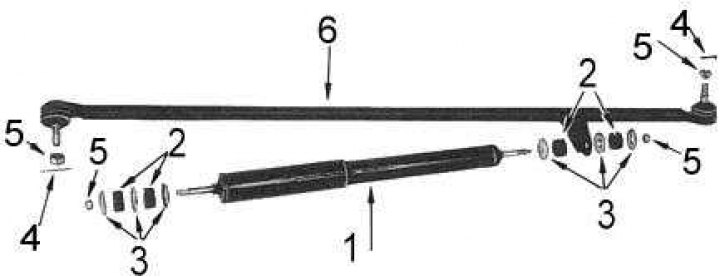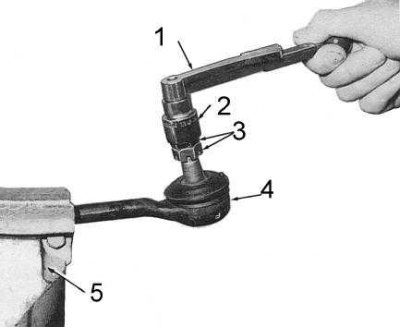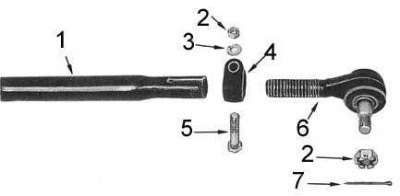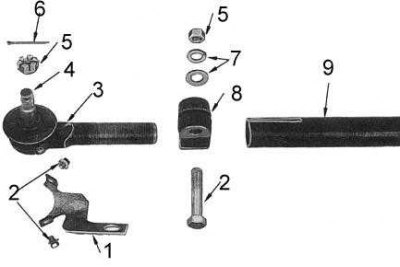Note. You will need a sensitive torque wrench to measure the rotational force of the ball joint.
Models Hardtop (Hardtop) and Universal (Station Wagon)
Attention! Tie rod and steering damper
Mutual arrangement and fastening details of the tie rod and steering damper

1 - steering damper; 2 - rubber bushings; 3 - washers; 4 - cotter pin; 5 - nut; 6 - transverse thrust
Removing
1. Jack up the front of the car and place it on jack stands. It may be necessary to remove the left front wheel to gain access to the left front ball joint.
2. On models of early years of release, give the nut securing the steering damper to the tie rod, remove the washer. Give a nut with a bolt of fastening of a damper to a cross jet bar and remove a damper from the car.
Note. On some models, the steering damper is attached to the chassis frame instead of the transverse torque rod. In this case, it is necessary to give the corresponding fastener instead of the mentioned one.
3. On models of later years of release, give the nuts from both ends of the steering damper, holding its rod motionless with a wrench. Remove the washers and rubber bushings, then remove the steering damper from under the vehicle.
4. Remove cotter pins from castle nuts at both ends of tie rod. Loosen the nuts.
5. If a puller is available, use it to release the tie rod ball joints from the steering knuckle and steering arm.
6. If a puller is not available, remove the ball joint pins by pressing the striker of one hammer against the appropriate landing ear and hit the back of the ear with the second hammer.
7. Remove the tie rod from the vehicle. Check the linkage for cracks and signs of deformation, replace if necessary.
8. Check the ball joints for axial play, for which grasp the joint with one hand, and with the other try to shake the ball pin from side to side. If there is play, replace the tie rod.
9. Check the turning force of the ball joints, for which screw the nuts, clamp the rod in a vise and rotate the ball pin with a sensitive torque wrench (see accompanying illustration). The nominal turning force of the ball joint is between 1.0 and 4.9 Nm. Replace the rod if necessary.

1 - torque wrench; 2 - replaceable end head; 3 - two nuts; 4 - ball joint; 5 - vise
10. Check up a condition of anthers spherical fingers. Replace defective ones.
11. Check the condition of all threads, replace defective components.
12. Grasp both ends of the steering damper and squeeze it hard several times until the end of the stroke. In the presence of jerks and jamming points, the damper must be replaced.
13. Inspect damper housing for dents, other damage, and signs of fluid leakage. Replace if necessary.
14. Check up a condition of rubber plugs of support of a damper. Replace defective bushings.
Installation
Installation is in the reverse order.
1. Tighten castle nuts to 46÷54 Nm.
2. Cotter pins must be replaced without fail.
3. Lubricate all joints with the recommended type of grease (see tables of sizes and adjustments at the end of the guide).
Tie Rod
Removing
1. Jack up the front of the car and place it on jack stands. It may be necessary to remove the wheels to gain access to the hinges.
2. Remove the castle nut cotter pins from both ends of the tie rod. Give me nuts.
3. If you have a puller, use it to release the tie rod ball joints from the steering knuckles.
4. If a puller is not available, use the alternative method described for tie rod joints.
5. Remove connecting draft from the car.
6. Check up draft on presence of cracks and signs of deformation. Replace if necessary.
7. Check the ball joints of the tips for the presence of axial play, for which grasp the joint with one hand, and with the other try to shake the ball pin from side to side. If there is play, replace the connecting rod.
8. Check the turning force of the ball joints, for which screw the nuts, clamp the rod in a vise and rotate the ball pin with a sensitive torque wrench. The nominal turning force of the ball joint is between 1.0 and 4.9 Nm. If necessary, replace the corresponding rod end.
9. Check up a condition of anthers spherical fingers. Replace defective ones.
10. Check the condition of all threads, replace defective components.
Installation
Installation is in the reverse order.
1. Measure the length of the rod between the centers of the ball joints of the tips. The nominal value is about 1270 mm. make adjustments if necessary. The tips should protrude from the rod by approximately the same number of threads (details of the tie rod end are shown in the accompanying illustration).

1 - connecting rod; 2 - nut; 3 - washer; 4 - clamp; 5 - bolt; 6 - tip; 7 - cotter pin
2. Tighten castle nuts to 46÷54 Nm.
3. Cotter pins must be replaced without fail.
4. Tighten the locking collars of the tie rod ends with a force of 25÷28 Nm.
5. Lubricate all joints with the recommended type of grease (see tables of sizes and adjustments at the end of the guide).
6. Check up installation of convergence of forward wheels of the car, in case of need make correction.
Utility Models (Van) (Utility) and mini truck
(Cab Chassis)
Steering Gear Components for Utility Models (Van) and mini truck (dimension A is 1236 mm)

1 - nut; 2 - steering damper; 3 - washers; 4 - transverse steering rod; 5 - cotter pin; 6 - assembly of the pendulum lever of the transverse steering rod; 7 - longitudinal steering rod; 8 - connecting steering rod
Removing
Longitudinal tie rod
1. Jack up the front of the car and place it on jack stands.
2. Remove the castellated nut cotter pins from both ends of the tie rod. Give me nuts.
3. If available, use a puller to remove the trailing link ball joints from the tie rod and assemble the tie rod pendulum arm.
4. If a puller is not available, proceed with the alternative method described for the Hardtop and Station wagon linkage joints.
5. Remove longitudinal draft from the car.
Tie rod
1. Jack up the front of the car and place it on jack stands.
2. Remove the castle nut cotter pins from both ends of the tie rod. Give me nuts.
3. Give a nut of fastening of a steering damper, remove a washer (s) and lift the damper up by removing it from the stud on the cross bar.
4. If available, use a puller to separate the tie rod ball studs from the swingarm and steering arm assembly.
5. If a puller is not available, use the alternative method described for the Hardtop and Station wagon linkage joints.
6. Remove the tie rod from the vehicle.
7. Check up draft on presence of cracks and signs of deformation. Replace if necessary.
Tie Rod
1. Jack up the front of the car and place it on jack stands. It may be necessary to remove the wheels to gain access to the hinges.
2. Remove the castle nut cotter pins from both ends of the tie rod and from the tie rod. Give me nuts.
3. If available, use a puller to separate the tie rod ball joints from the steering knuckle and tie rod.
4. If a puller is not available, proceed with the alternative method described for the Hardtop and Station wagon linkage joints.
5. Remove connecting draft from the car.
6. If necessary, loosen the lock plate bolts (see accompanying illustration) and bolts of collars of fixing of tips of connecting draft. Remove the tips. Count and record the number of revolutions required to unscrew each tip.

1 - locking plate; 2 - bolts; 3 - thrust tip; 4 - ball pin of the hinge; 5 - nut; 6 - cotter pin; 7 - washers; 8 - clamp; 9 - connecting rod
Checking the Status of Components
1. Check all steering gear components for signs of wear and damage.
2. Check the ball joints of the rods for the presence of axial play, for which grasp the joint with one hand, and with the other try to shake the ball pin from side to side. If there is play, replace the joint.
3. Check the turning force of the ball joints of the rods, for which screw the nuts, clamp the rod in a vise and rotate the ball pin with a sensitive torque wrench. The nominal turning force of the ball joint is between 1.0 and 4.9 Nm. Replace defective hinges.
4. Check up a condition of anthers spherical fingers. Replace defective ones.
5. Check the condition of all threads, replace defective components.
Installation
Installation is in the reverse order.
1. If removed, establish tips on connecting steering draft, having screwed them on a former quantity of turns.
Note. Overall length of tie rod assembly (1236 mm) must be measured between the centers of the ball studs of the tips.
2. Install the locking plates on the tie rod ends.
3. Tighten castle nuts and bolts of collars of fastening of tips of connecting draft with demanded effort.
4. Cotter pins must be replaced without fail.
5. Lubricate all joints with the recommended type of grease (see tables of sizes and adjustments at the end of the guide).
6. Check up installation of convergence of forward wheels of the car, in case of need make correction.